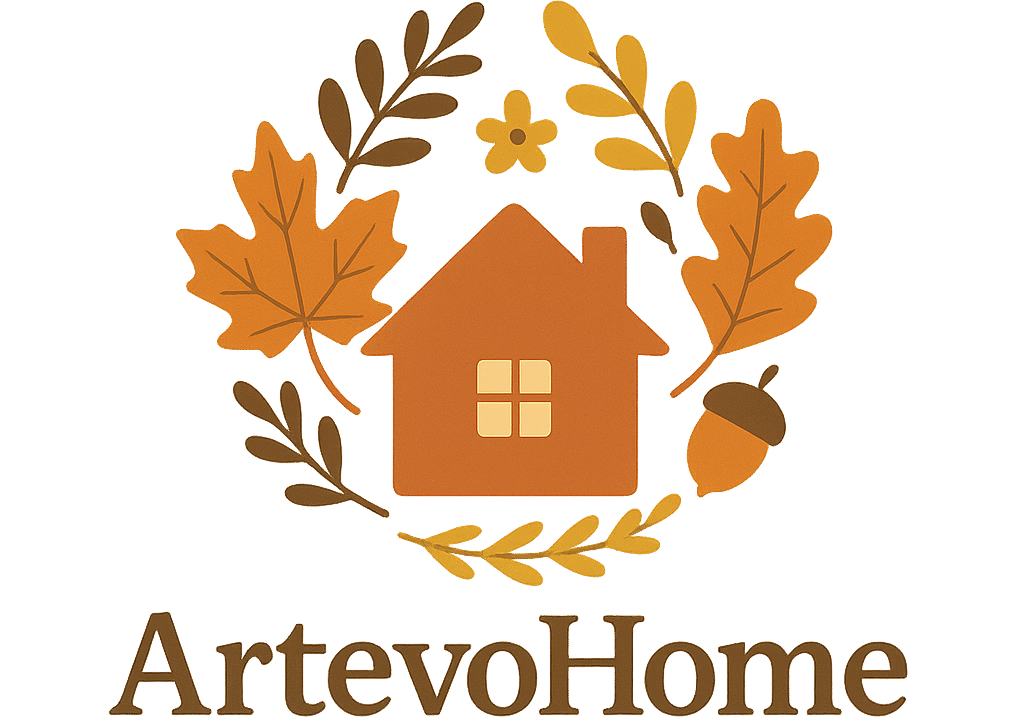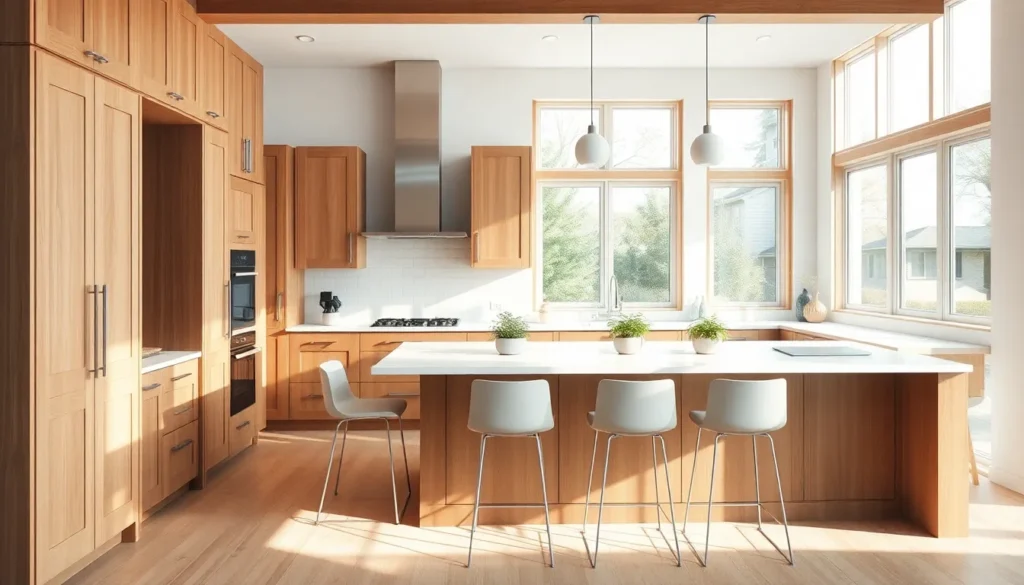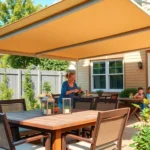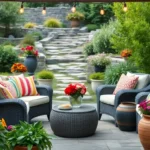We’ve all stood in our kitchens wondering how to bridge the gap between traditional charm and modern functionality. Transitional kitchen design offers the perfect solution by seamlessly blending classic elements with contemporary features to create spaces that feel both timeless and current.
This design style has become increasingly popular among homeowners who don’t want to choose between cozy traditional warmth and sleek modern efficiency. We’re seeing more kitchens that incorporate clean lines alongside rich textures natural materials paired with sophisticated finishes and classic details enhanced by cutting-edge appliances.
Whether you’re planning a complete kitchen renovation or looking to refresh your existing space transitional design provides endless possibilities. We’ll explore practical ideas that’ll help you achieve this balanced aesthetic while maximizing both style and functionality in your kitchen.
Define Your Transitional Kitchen Style Foundation
Creating a successful transitional kitchen starts with establishing clear design principles that guide every decision. We’ll explore the essential elements that form the backbone of this versatile style.
Blend Traditional and Contemporary Elements
Mixing classic cabinetry with modern hardware creates the perfect transitional foundation. We recommend combining raised panel doors with sleek stainless steel handles or contemporary pulls. Traditional elements like crown molding and decorative trim work beautifully alongside clean-lined kitchen islands and minimalist backsplashes.
Incorporate vintage-inspired lighting fixtures with contemporary finishes. Pendant lights featuring classic silhouettes in brushed nickel or matte black provide the ideal bridge between old and new. We suggest pairing traditional chandelier styles with modern LED technology for both aesthetic appeal and energy efficiency.
Balance ornate details with simplified surfaces throughout your space. Consider adding traditional beadboard wainscoting below sleek quartz countertops, or install classic subway tiles in a contemporary herringbone pattern. These combinations create visual interest while maintaining the transitional kitchen’s signature harmony.
Choose a Neutral Color Palette
Establish your foundation with warm whites and soft grays as primary colors. We find that colors like Benjamin Moore’s Cloud White or Sherwin Williams’ Agreeable Gray provide the perfect backdrop for transitional elements. These shades complement both traditional wood tones and contemporary stainless steel appliances.
Layer different neutral tones to add depth without overwhelming the space. Combine cream-colored cabinets with greige walls and warm beige accents through textiles and accessories. We recommend using the 60-30-10 rule: 60% dominant neutral, 30% secondary neutral, and 10% accent color for optimal balance.
Introduce subtle earth tones through natural materials and textures. Warm honey oak flooring, natural stone countertops, and woven basket storage add organic elements that enhance the transitional aesthetic. These materials bring warmth to neutral palettes while maintaining the style’s sophisticated appeal.
Balance Formal and Casual Design Elements
Combine elegant materials with relaxed furniture pieces for optimal transitional flow. We suggest pairing marble countertops with comfortable bar stools featuring upholstered seats, or installing formal coffered ceilings above a casual farmhouse dining table. This juxtaposition creates the welcoming yet refined atmosphere transitional kitchens are known for.
Mix structured architectural details with soft textile elements throughout the room. Consider adding formal built-in cabinetry alongside casual window treatments like linen curtains or woven roman shades. We recommend incorporating both customized and relaxed seating options to accommodate different occasions and family activities.
Alternate between polished and textured finishes to achieve visual balance. Glossy subway tiles pair beautifully with matte cabinet hardware, while smooth quartz counters complement textured wood grain details. We find that this interplay of surfaces adds sophistication without feeling overly formal or sterile.
Select Transitional Kitchen Cabinetry That Works
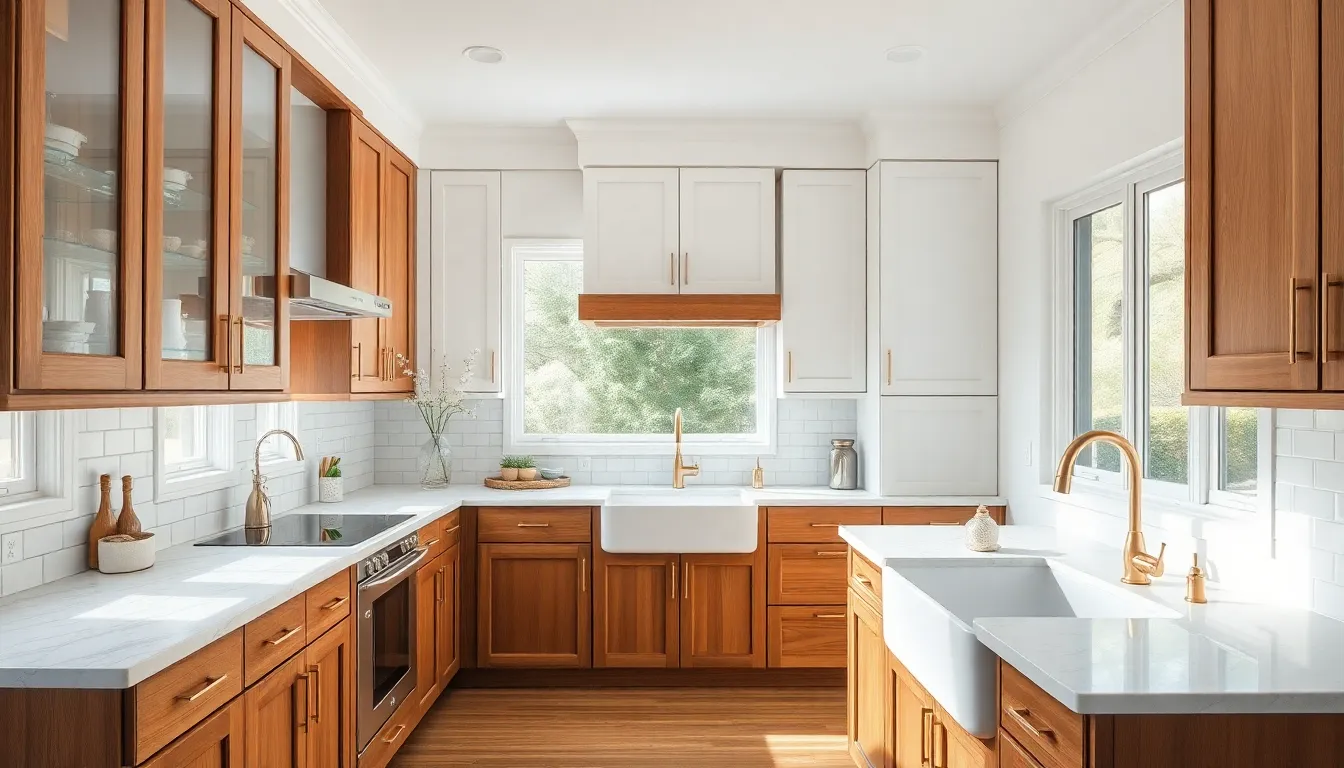
Cabinetry serves as the foundation of any transitional kitchen design, setting the tone for the entire space. We’ll explore strategic cabinet choices that seamlessly blend traditional and contemporary elements.
Opt for Shaker-Style Cabinet Doors
Shaker-style doors represent the perfect marriage of classic design and modern simplicity in transitional kitchens. These doors feature clean lines and minimal ornamentation, making them versatile enough to work with various hardware styles and finishes. We recommend choosing Shaker cabinets because they offer timeless appeal without overwhelming the space with decorative details.
Frame and panel construction creates subtle depth while maintaining the streamlined aesthetic that defines transitional design. Cabinet doors with this profile complement both traditional elements like farmhouse sinks and contemporary features such as sleek countertops. Standard Shaker profiles work beautifully with brushed gold hardware for warmth or matte black fixtures for modern contrast.
Mix Cabinet Finishes and Materials
Combining different cabinet finishes adds visual interest and prevents your transitional kitchen from appearing too uniform. We suggest pairing warm wood tones with painted cabinets to create depth and dimension throughout the space. Upper cabinets in crisp white or soft gray can lighten the room, while lower cabinets in natural wood bring warmth to the foundation.
Two-tone cabinet combinations work particularly well when you use darker colors on the island and lighter shades on perimeter cabinets. Natural wood species like oak or maple provide rich texture against painted surfaces. Mixing materials such as wood grain with smooth painted finishes creates the layered look that makes transitional kitchens so appealing.
Incorporate Both Upper and Lower Cabinet Storage
Strategic cabinet placement maximizes storage while maintaining the balanced proportions essential to transitional design. Upper cabinets should house items you use less frequently, such as seasonal serving pieces or specialty appliances. Lower cabinets work best for everyday essentials like pots, pans, and frequently accessed dishes.
We recommend extending upper cabinets to the ceiling to create a cohesive, built-in appearance that emphasizes vertical space. Glass-front upper cabinets can display attractive dishware while keeping the room feeling open. Deep drawers in lower cabinets offer better accessibility than traditional shelving, allowing you to organize items more efficiently while maintaining the clean lines that define transitional style.
Choose Versatile Kitchen Islands and Peninsulas
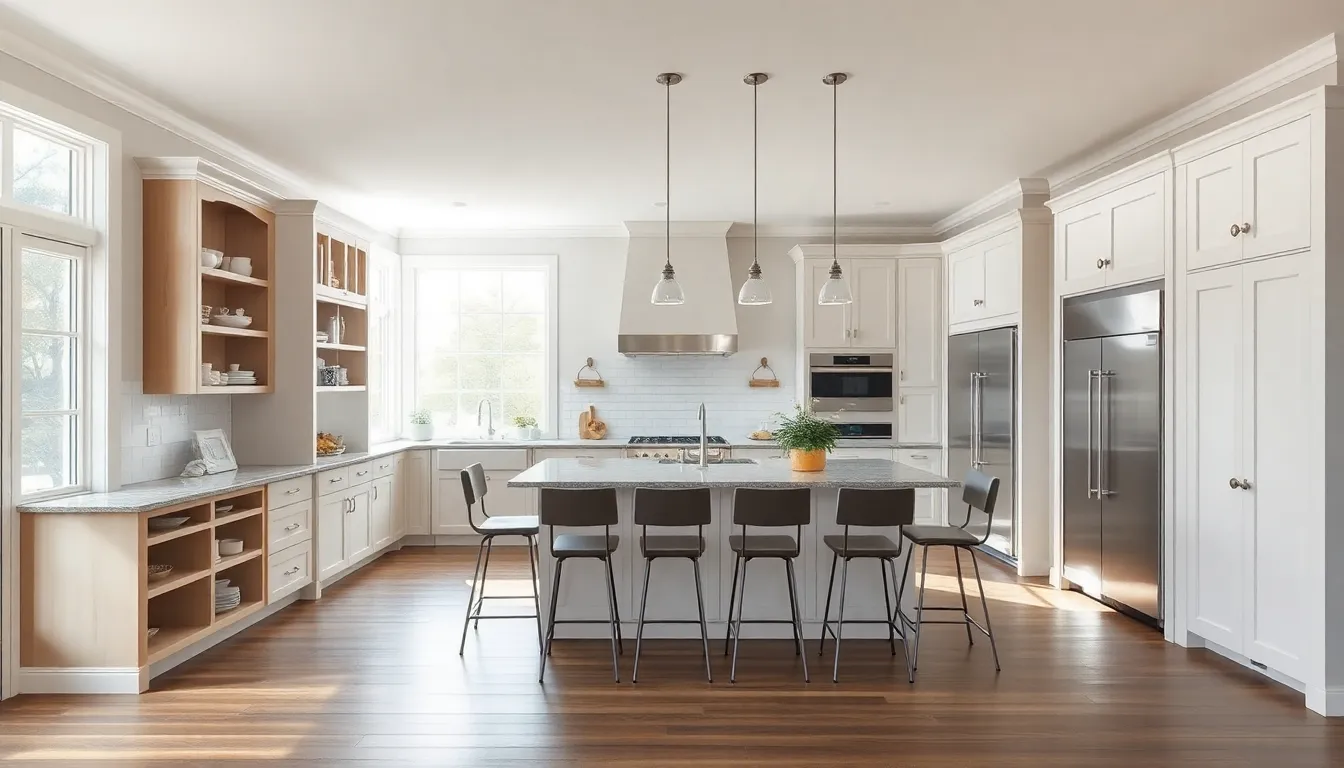
Islands and peninsulas serve as the focal point of our transitional kitchen design while maximizing both functionality and aesthetic appeal. These central elements bridge traditional charm with modern convenience seamlessly.
Design Multi-Functional Kitchen Islands
Multi-functional islands transform our kitchen workflow by incorporating essential storage and utility features. We recommend adding cabinets directly into the island structure to house cookware, dishes, and pantry items efficiently. Pull-out storage drawers maximize accessibility while maintaining the clean lines characteristic of transitional design.
Built-in appliances elevate the island’s functionality significantly. We suggest incorporating a prep sink or cooktop surface to create dedicated cooking zones that enhance our kitchen’s efficiency. Hanging spaces for pots and pans above the island provide easy access while adding visual interest to the space.
Storage answers should include a combination of open shelving and closed cabinets. We find that mixing these elements creates the perfect balance between display opportunities and concealed organization that transitional kitchens require.
Add Seating for Casual Dining
Integrated seating transforms our kitchen island into a social gathering space for family meals and entertaining. We recommend incorporating bar stools or a built-in banquette that complements our transitional design aesthetic while providing comfortable dining options. Counter-height seating works particularly well for casual breakfast conversations and assignments supervision.
Flexible layouts ensure our seating arrangement doesn’t obstruct the natural kitchen workflow. We position stools to allow easy movement around the island while maintaining clear pathways between major appliances and work zones. This strategic placement creates an inviting atmosphere without compromising functionality.
Banquette seating offers additional storage opportunities beneath the cushions. We use this hidden space for storing linens, seasonal items, or kitchen gadgets that we use less frequently.
Include Storage and Workspace Answers
Wall-mounted cabinets and shelves optimize our vertical storage capacity while keeping countertops clear for food preparation. We strategically place upper cabinets to provide easy access to frequently used items without overwhelming the transitional design’s balanced proportions.
Countertop workspace requires careful planning to ensure adequate room for multiple cooking tasks. We recommend maintaining at least 36 inches of continuous counter space on one side of the island for efficient meal preparation and cooking activities.
Natural light enhancement through large windows or skylights brightens our transitional kitchen workspace significantly. We position our island to take advantage of existing light sources while ensuring adequate task lighting for evening cooking sessions. This combination creates an inviting atmosphere that showcases both traditional warmth and modern functionality.
Install Timeless Countertop Materials
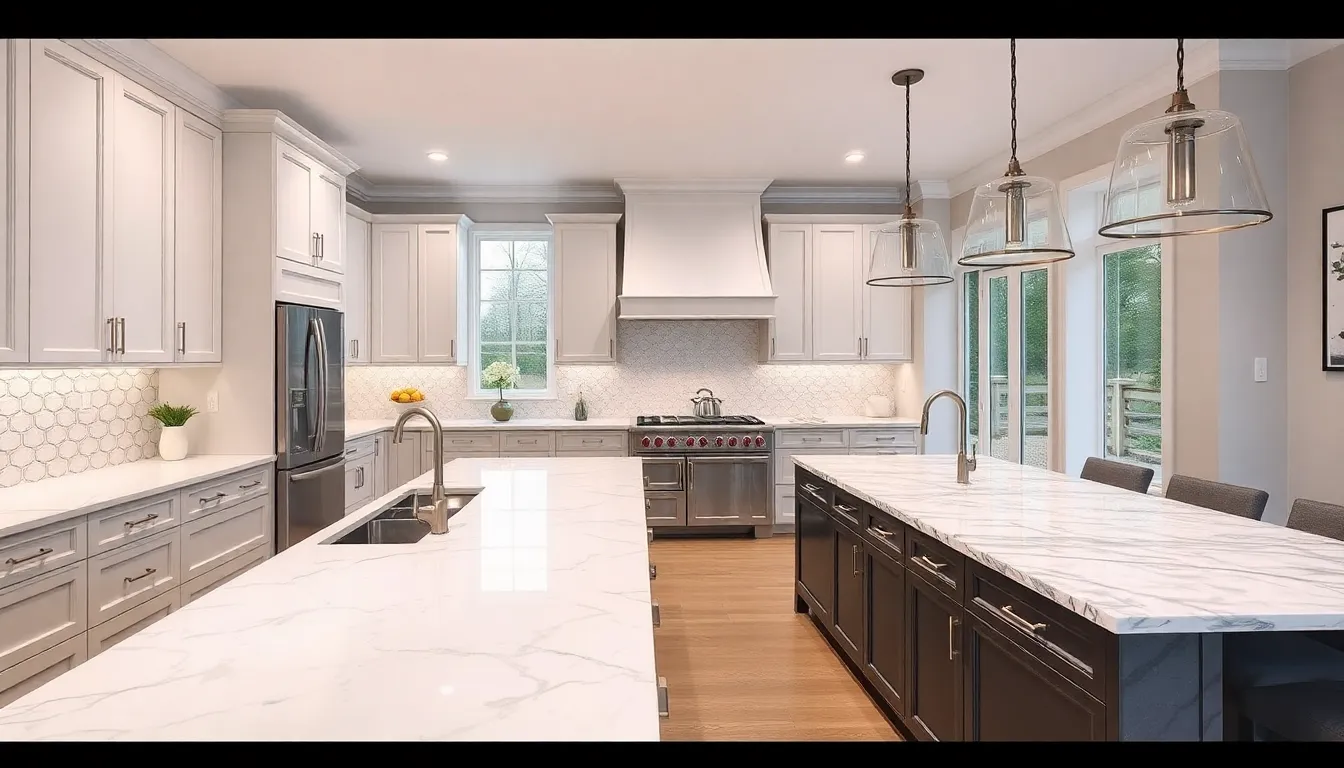
Countertops serve as the foundation for your transitional kitchen’s aesthetic, bridging the gap between traditional elegance and modern functionality. We’ll explore durable materials that offer both classic appeal and contemporary performance for your kitchen transformation.
Consider Quartz for Durability and Style
Quartz countertops represent the perfect marriage of beauty and practicality in transitional kitchen design. These engineered surfaces offer exceptional durability and scratch resistance, making them ideal for busy households that demand both style and performance.
We love how quartz mimics natural stone patterns like marble or granite while providing superior resilience and low maintenance requirements. The wide range of colors and finishes available allows you to complement neutral cabinetry and modern fixtures seamlessly.
Quartz surfaces resist stains and require minimal upkeep, eliminating the need for regular sealing that natural stones demand. This practical advantage makes quartz particularly appealing for families who want high-end aesthetics without intensive maintenance routines.
Explore Natural Stone Options
Natural stone countertops bring authentic elegance and character to transitional kitchens through their unique patterns and timeless appeal. Granite stands out for its exceptional strength and distinctive veining, creating stunning focal points that complement both traditional and contemporary elements.
Marble offers classic sophistication with its luxurious appearance, though it requires more careful maintenance than other options. We recommend marble for homeowners who appreciate natural beauty and don’t mind the additional care required to preserve its pristine condition.
Both granite and marble pair beautifully with neutral cabinetry and modern fixtures, maintaining the balanced aesthetic that defines transitional design. These natural materials add warmth and authenticity that engineered surfaces can’t fully replicate.
Mix Countertop Materials for Visual Interest
Combining different countertop materials throughout your kitchen creates compelling visual contrast while highlighting each material’s unique qualities. We often recommend using quartz on the main island for everyday durability while featuring marble on a separate prep area as a statement piece.
This mixed approach reinforces transitional style’s fundamental principle of blending old and new elements harmoniously. The contrast between materials adds depth and sophistication to your kitchen design without overwhelming the space.
Strategic material placement allows you to enjoy the benefits of both options while creating distinct zones within your kitchen. Consider your cooking habits and maintenance preferences when deciding which materials to use in different areas.
Incorporate Balanced Lighting Solutions
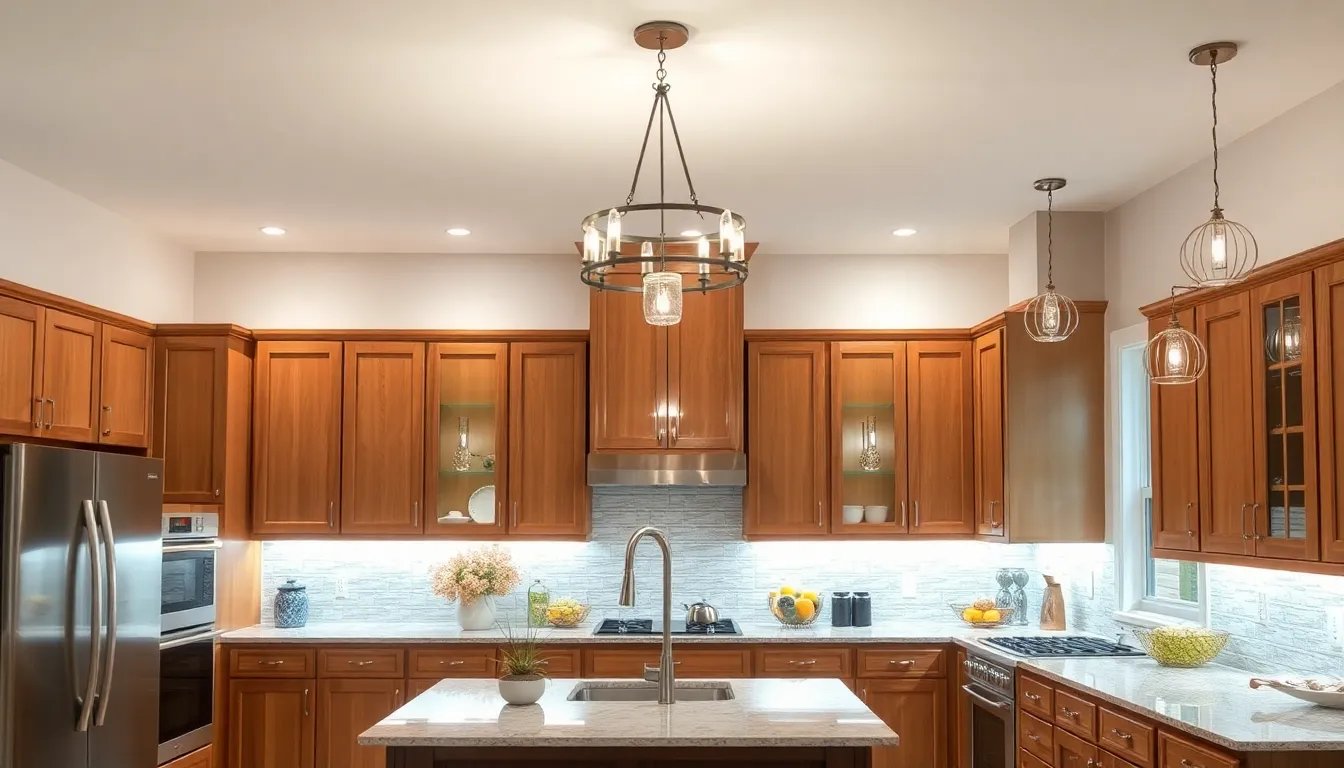
Lighting transforms transitional kitchens from functional spaces into warm, inviting environments that balance traditional charm with modern convenience. We’ll explore how strategic lighting choices enhance both the aesthetic appeal and practical functionality of your transitional kitchen design.
Layer Ambient, Task, and Accent Lighting
Balanced lighting creates depth and visual interest while ensuring every corner of your transitional kitchen serves its purpose effectively. We recommend implementing a three-tier lighting strategy that combines ambient, task, and accent elements for optimal results.
Ambient lighting provides overall illumination throughout the space, typically achieved through ceiling-mounted fixtures or recessed lighting systems. This foundational layer ensures comfortable movement and general visibility during daily activities.
Task lighting focuses on exact work areas where precision matters most, such as countertops, cooking surfaces, and prep zones. Under-cabinet LED strips, pendant lights over islands, and directional spotlights deliver concentrated illumination where you need it most.
Accent lighting highlights architectural features, decorative elements, or design focal points that showcase your transitional style. Display cabinet lighting, toe-kick illumination, and decorative fixtures add visual drama while reinforcing the balanced aesthetic.
Choose Statement Light Fixtures
Statement lighting fixtures serve as functional art pieces that bridge traditional elegance with contemporary sophistication. We suggest selecting linear chandeliers, oversized pendants, or multi-light fixtures that complement your transitional design theme.
Linear chandeliers work exceptionally well over kitchen islands, combining classic chandelier elements with modern geometric forms. These fixtures provide adequate task lighting while serving as striking visual anchors that enhance the overall balance.
Pendant groupings offer versatility in both style and placement, allowing you to mix materials like glass, metal, and fabric shades. Choose finishes such as brushed nickel or matte black that harmonize with your cabinetry hardware and other design elements.
Integrated LED technology ensures energy efficiency while providing consistent, long-lasting illumination. This modern approach to lighting aligns with transitional design principles by combining practical innovation with timeless aesthetic appeal.
Add Under-Cabinet Lighting for Functionality
Under-cabinet lighting eliminates shadows on work surfaces while creating a warm, inviting ambiance that enhances your transitional kitchen’s welcoming atmosphere. We recommend installing LED strip lights or puck lights beneath upper cabinets for optimal task illumination.
LED strip lighting provides continuous, even illumination across entire countertop sections, making food preparation safer and more efficient. This lighting solution integrates seamlessly with your cabinet design while offering dimming capabilities for ambient evening lighting.
Puck lights create focused pools of light that work particularly well in kitchens with varied cabinet heights or unique architectural features. These fixtures allow for precise placement and can be adjusted to highlight exact work zones or decorative elements.
Warm color temperatures between 2700K and 3000K complement the cozy, inviting nature of transitional design while providing adequate brightness for detailed tasks. This temperature range enhances natural wood tones and creates a comfortable cooking environment that feels both functional and welcoming.
Select Harmonious Flooring Options
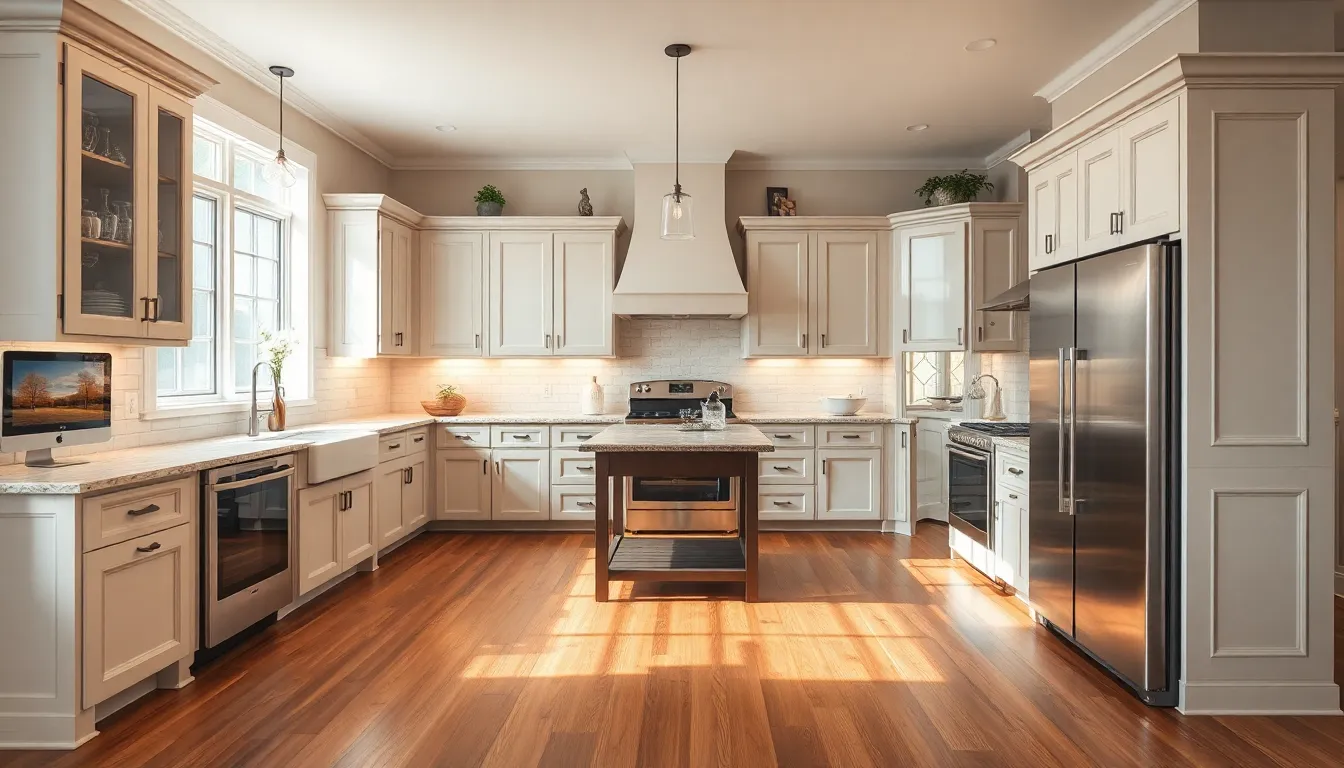
Transitional kitchens require flooring that bridges the gap between traditional warmth and contemporary functionality. We’ll explore the most effective flooring options that complement this balanced design approach.
Choose Hardwood for Warmth and Elegance
Hardwood floors remain the gold standard for transitional kitchens due to their classic appeal and natural warmth. Oak, maple, and walnut species offer the versatility needed to coordinate with both traditional cabinetry and modern appliances. Neutral and mid-tone stains work best, providing a sophisticated backdrop that doesn’t compete with other design elements.
Durability makes hardwood an excellent long-term investment for busy kitchens. We can refinish these floors over time, maintaining their beauty while adapting to evolving design preferences. Traditional plank widths typically range from 3 to 5 inches, while wider planks create a more contemporary feel that still honors classic sensibilities.
Installation patterns also influence the overall aesthetic. Straight lay patterns offer timeless appeal, while herringbone or chevron arrangements add subtle visual interest without overwhelming the space. Matte or satin finishes enhance the transitional look better than high-gloss options, which can appear too formal or modern.
Consider Luxury Vinyl for Practicality
Luxury vinyl flooring provides water resistance and durability that busy kitchens demand. LVT and LVP options now offer realistic textures and patterns that convincingly mimic wood, stone, and ceramic materials. Modern manufacturing techniques create planks with authentic wood grain details and natural color variations.
Maintenance becomes effortless with luxury vinyl, requiring only regular sweeping and occasional damp mopping. We appreciate the comfort underfoot that luxury vinyl provides, especially important in kitchens where we spend considerable time standing. High-traffic areas benefit from luxury vinyl’s scratch resistance and ability to withstand dropped utensils and appliances.
Cost effectiveness makes luxury vinyl attractive for homeowners seeking the transitional look without hardwood’s price point. Installation costs remain lower than natural materials, and many luxury vinyl products feature click-lock systems that simplify the process. Thickness options range from 4mm to 8mm, with thicker planks providing better sound absorption and feel.
Coordinate Flooring with Overall Design
Flooring coordination requires careful consideration of existing cabinetry, countertops, and backsplash materials. Neutral colors like beige, light brown, and greige provide the subtle backdrop transitional kitchens need. We avoid high-contrast combinations that create visual competition between flooring and other elements.
Color temperature matching ensures harmony throughout the space. Warm undertones in flooring should complement warm cabinet stains, while cooler tones work better with painted cabinets in whites and grays. Natural variations in wood grain or luxury vinyl patterns add interest without creating busy visual noise.
Stone-look vinyl and ceramic tiles offer additional options where water resistance takes priority. We select these materials in neutral tones that support the transitional aesthetic rather than dominating it. Border treatments and transition strips between different flooring materials should blend seamlessly to maintain the unified look that defines successful transitional design.
Add Personality Through Hardware and Fixtures
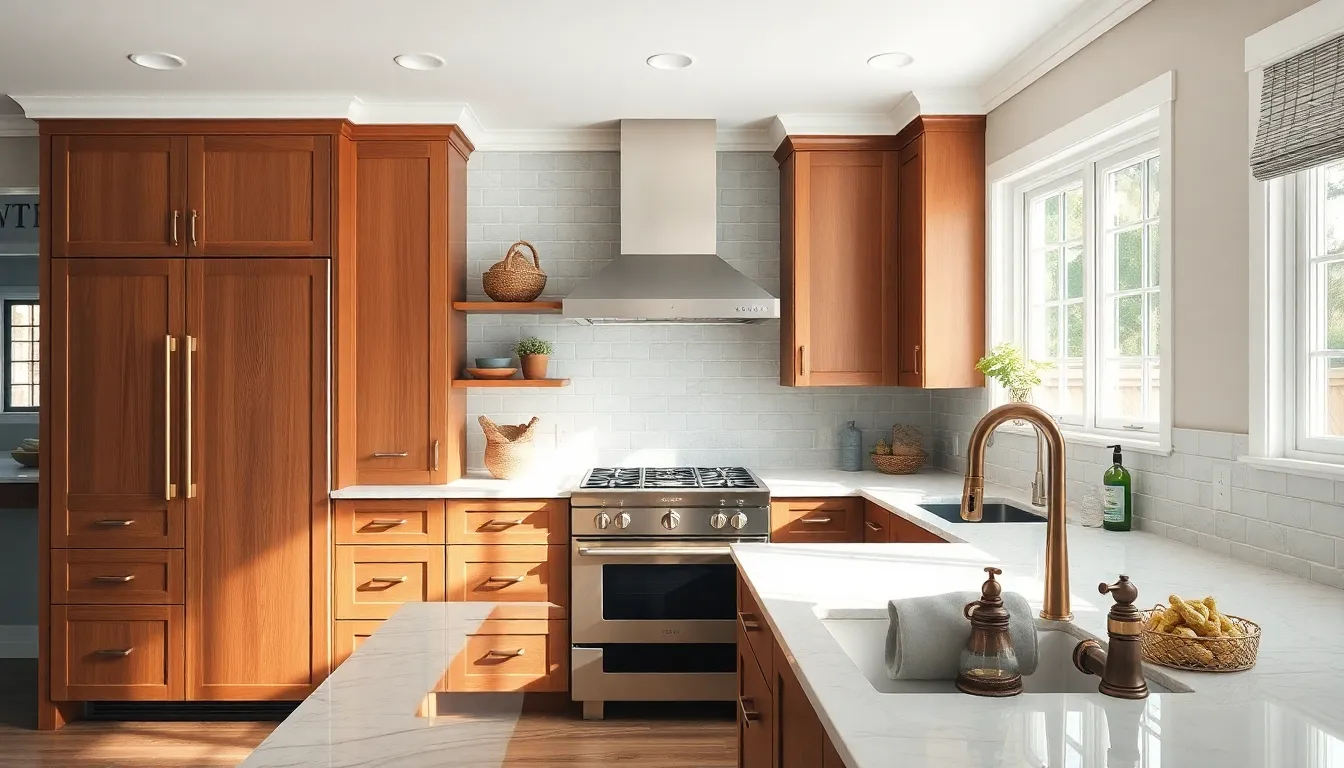
Hardware and fixtures serve as the jewelry of your transitional kitchen, offering an opportunity to infuse character while maintaining the balanced aesthetic you’ve established. These finishing touches can elevate your design from ordinary to extraordinary.
Select Mixed Metal Finishes
Combining different metal finishes creates visual depth and sophistication in transitional kitchen design. Brass pairs beautifully with stainless steel appliances, while copper accents add warmth against cool-toned countertops. Bronze finishes complement wood cabinetry particularly well, creating rich contrast that enhances both traditional and modern elements.
We recommend limiting yourself to three metal finishes maximum to avoid overwhelming the space. Popular combinations include brass with stainless steel and matte black, or bronze with copper and brushed nickel. Mixed metals work best when distributed throughout the kitchen rather than clustered in one area.
Consider the undertones of your chosen metals to ensure harmony. Warm metals like brass and copper complement cream and beige color schemes, while cooler metals such as stainless steel and chrome pair well with gray and white palettes.
Choose Classic Hardware Styles
Classic hardware styles provide the foundation for transitional kitchen personality while ensuring longevity. Knobs work exceptionally well on cabinet doors, offering a clean, timeless appearance that doesn’t compete with other design elements. Handles suit drawers and larger cabinet doors, providing both functionality and visual weight.
Cup pulls add vintage charm to transitional designs, particularly when used on kitchen islands or lower cabinets. Bar pulls create sleek lines that enhance modern elements while maintaining classic proportions. Ring pulls offer an elegant option for upper cabinets, adding subtle traditional character without overwhelming the space.
We suggest choosing hardware with substantial weight and quality construction, as these pieces endure daily use. Solid brass, stainless steel, and bronze hardware typically offer the best durability and aging characteristics for transitional kitchens.
Coordinate Faucets and Cabinet Hardware
Coordination between faucets and cabinet hardware creates a cohesive look that ties your transitional kitchen together. Matching your faucet finish to your primary hardware finish establishes a strong design foundation, while allowing secondary hardware to complement in a different metal.
Bridge faucets work particularly well in transitional designs, combining traditional styling with modern functionality. Farmhouse style faucets add rustic charm while maintaining clean lines appropriate for contemporary elements. Pull down spray faucets offer practical benefits without sacrificing aesthetic appeal.
We recommend selecting faucets first since they’re typically the largest hardware element, then choosing cabinet hardware that coordinates with the finish. If you’ve chosen a brass faucet, brass or warm bronze cabinet hardware creates harmony, while a secondary metal like matte black can provide contrast on select pieces like island hardware or pantry pulls.
Create Visual Interest with Backsplash Designs
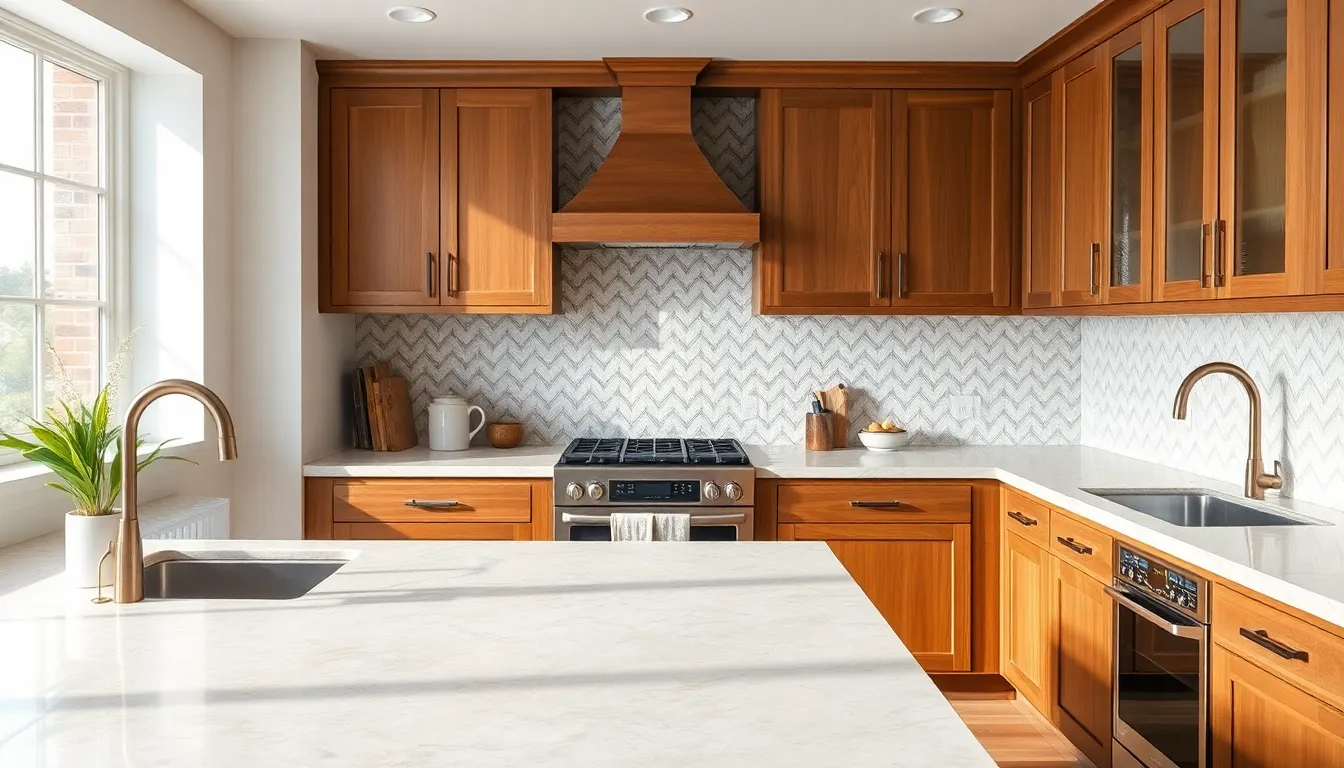
Your backsplash serves as the perfect canvas to showcase transitional kitchen design elements. We’ll explore how different materials and patterns can enhance your space while maintaining that balanced aesthetic.
Use Subway Tiles for Timeless Appeal
Subway tiles remain our top recommendation for creating lasting visual impact in transitional kitchens. These versatile rectangular tiles work beautifully in glass, ceramic, or marble materials, giving you flexibility to match your exact design vision. Classic horizontal installations provide a clean, traditional look that pairs perfectly with Shaker cabinetry and modern appliances.
We suggest experimenting with herringbone patterns to add contemporary flair while maintaining the subway tile’s timeless character. This arrangement creates subtle movement and texture without overwhelming your neutral color palette. The beauty of subway tiles lies in their ability to complement both warm wood tones and sleek stainless steel elements seamlessly.
Incorporate Natural Stone or Marble
Natural stone and marble backsplashes elevate transitional kitchens with sophisticated luxury that bridges traditional elegance and modern functionality. These materials introduce organic patterns and textures that create visual depth while maintaining the refined aesthetic your space deserves. We recommend selecting stones with subtle veining to complement your quartz countertops without competing for attention.
Marble subway tiles offer the perfect compromise between classic subway appeal and natural stone beauty. Their unique variations ensure no two installations look identical, adding personality to your kitchen design. Consider honed finishes for a more casual feel or polished surfaces when you want to emphasize the marble’s inherent elegance.
Add Texture with Patterned Tiles
Patterned tiles provide the perfect opportunity to introduce visual interest while respecting transitional design principles. Geometric patterns work exceptionally well, creating focal points that don’t overwhelm your carefully balanced color scheme. We particularly love mosaic tiles that combine multiple neutral tones, allowing you to tie together various kitchen elements.
Textured tile surfaces add tactile dimension that enhances your kitchen’s sensory appeal. Consider tiles with raised patterns or dimensional surfaces that catch light beautifully throughout the day. These options work especially well behind ranges or prep areas, creating defined zones while maintaining your kitchen’s cohesive flow from traditional warmth to contemporary convenience.
Integrate Smart Storage Solutions
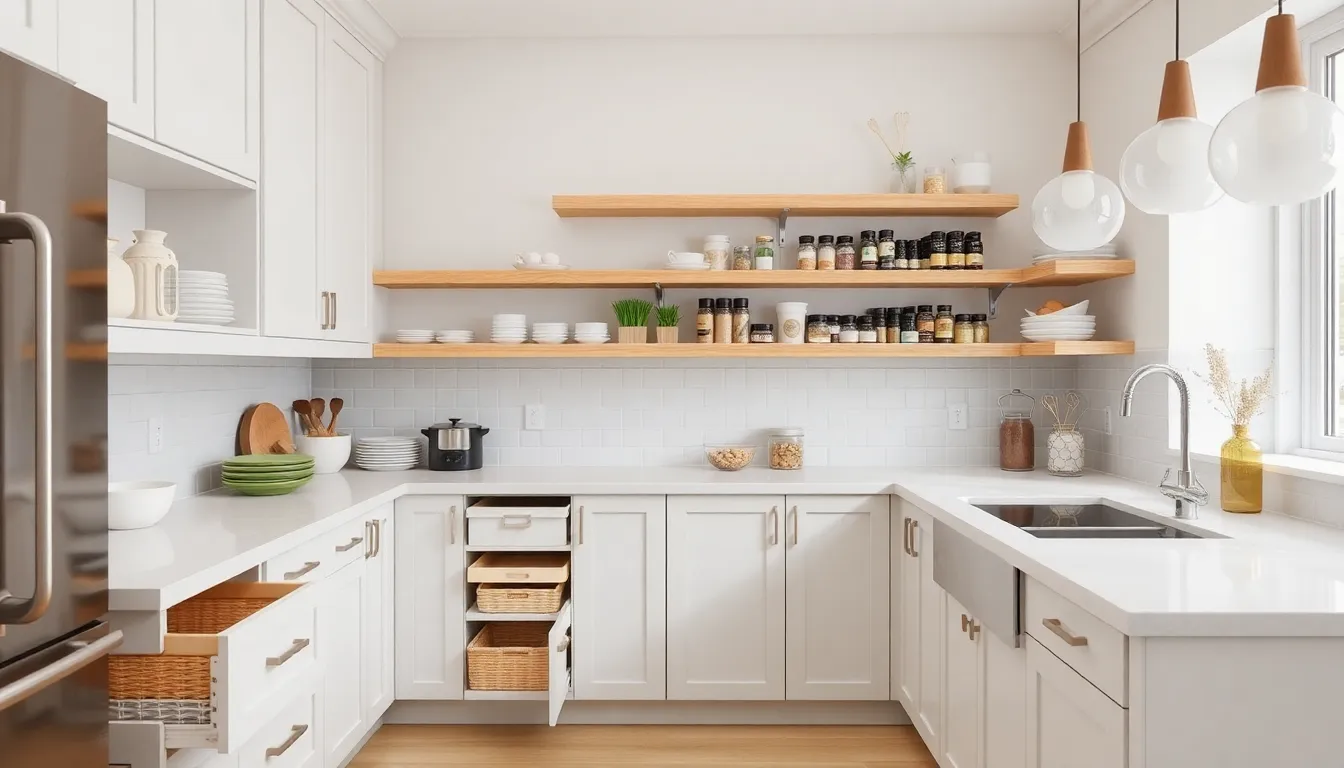
Smart storage lies at the heart of successful transitional kitchen design, transforming cluttered spaces into organized, functional work areas that maintain their aesthetic appeal.
Maximize Cabinet Organization
Decluttering creates the foundation for effective cabinet organization in transitional kitchens. We recommend removing unused items and categorizing everything by frequency of use to establish a logical storage system.
Replacing lower cabinets with pull-out drawer systems eliminates the need to bend or kneel while accessing heavy cookware and frequently used tools. These systems provide full visibility and easy retrieval of items stored in deep cabinet spaces.
Installing customized drawer compartments for cutlery, spices, and utensils optimizes organization while reducing visual clutter. Adjustable dividers allow us to modify storage configurations as our needs change over time.
Utilizing corner cabinets with rotating lazy Susans transforms previously difficult-to-reach spaces into accessible storage areas. We can dedicate these corner spaces to infrequently used items while keeping everyday essentials within easy reach.
Add Pull-Out Drawers and Shelves
Incorporating pull-out drawers provides seamless access to deep or lower cabinets, making it simple to store and retrieve pots, pans, and pantry staples. These mechanisms eliminate the frustration of reaching into dark cabinet depths.
Installing pull-down shelving in upper cabinets brings items within comfortable reach without requiring step stools or stretching. This feature proves especially valuable for storing dishes and glassware in transitional kitchen designs.
Adding pull-out spice racks keeps seasonings organized and visible while maintaining the clean lines essential to transitional aesthetics. These concealed storage answers integrate seamlessly with cabinet faces.
Including concealed trash bins on pull-out mechanisms maintains the sophisticated appearance of transitional kitchens while improving convenience during meal preparation and cleanup.
Include Pantry Storage Options
Building pantry cabinets with adjustable shelving accommodates bulk storage of dry goods and kitchen essentials while blending with surrounding cabinetry. These integrated answers maximize space utilization without disrupting design flow.
Creating closet pantries with floor-to-ceiling storage provides dedicated space for food items and small appliances. We recommend installing adjustable shelving systems that adapt to changing storage needs.
Installing open shelving or glass-front cabinets improves accessibility while visually expanding smaller kitchen spaces. These options showcase attractive dishware and create opportunities for decorative displays.
Incorporating wall-mounted racks provides additional storage for frequently used items while keeping countertops clear. These systems work particularly well in transitional designs where function meets form seamlessly.
Finish with Transitional Decorative Elements
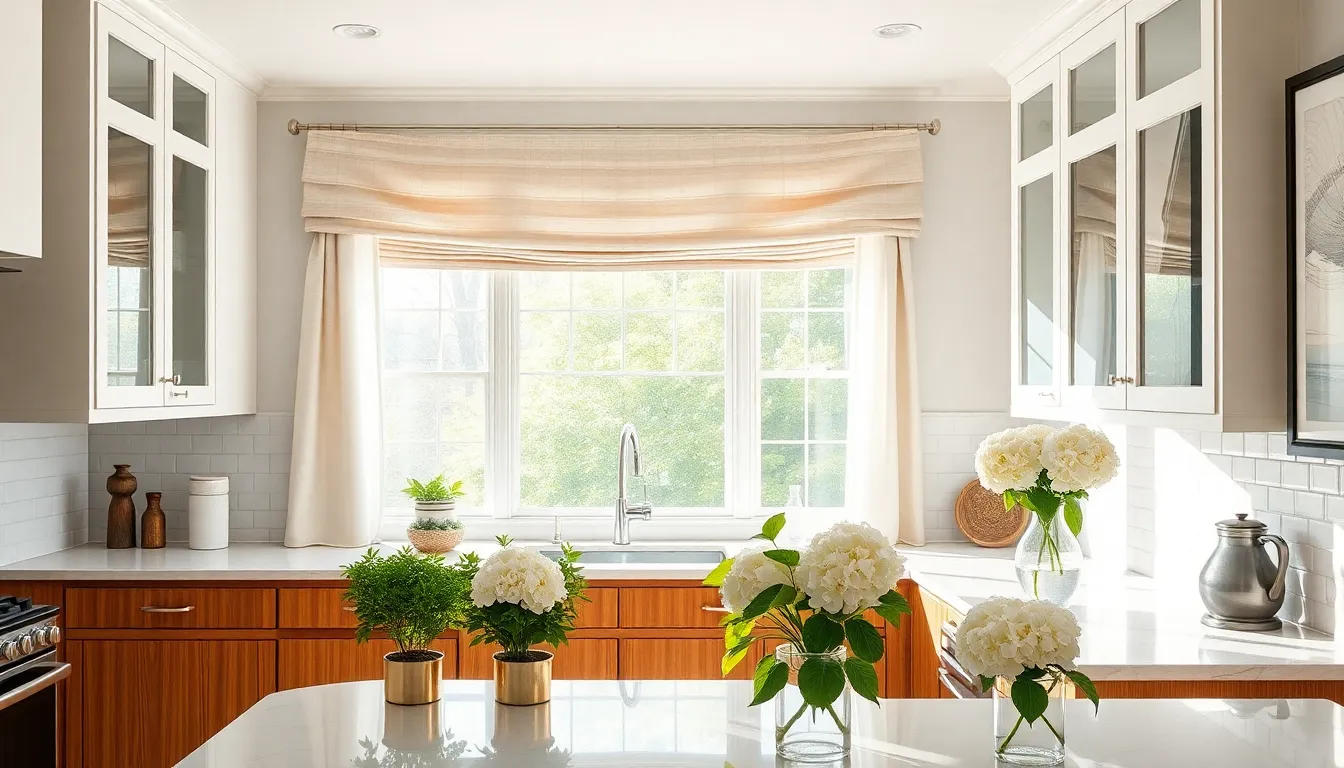
Transitional kitchens blend classic and modern elements to create a timeless appeal that feels both sophisticated and inviting. We can achieve this balanced aesthetic by incorporating thoughtful decorative touches that enhance the space’s warmth and character.
Add Greenery and Natural Elements
Plants bring life and energy to transitional kitchen spaces while softening the clean lines of modern cabinetry. We recommend placing fresh herbs like basil, rosemary, and thyme on windowsills or countertops to add both functionality and natural beauty. Potted plants create visual interest when positioned near kitchen islands or in corners where they won’t interfere with cooking activities.
Natural materials like wood and stone enhance the warmth and coziness of transitional kitchens. We can incorporate reclaimed wood cutting boards, stone fruit bowls, or wooden serving trays that complement the existing design elements. These organic textures create a welcoming atmosphere that balances the sleek surfaces of modern appliances and countertops.
Fresh flowers in simple vases add seasonal color and fragrance to the space. We suggest choosing blooms that complement the warm, neutral color palette typical of transitional design, such as white hydrangeas or soft pink peonies.
Choose Versatile Window Treatments
Minimalist window treatments allow abundant natural light to enter while maintaining privacy and style. We recommend selecting treatments that complement both traditional and modern elements without overwhelming the space. Roman shades in neutral fabrics like linen or cotton provide a clean, customized look that works well with transitional design principles.
Natural light creates a bright and energetic atmosphere that’s essential to transitional kitchen success. We can maximize this light by choosing sheer curtains or light filtering blinds that offer privacy during the day while allowing sunshine to illuminate the space. Wooden blinds in warm tones coordinate beautifully with natural elements and cabinetry finishes.
Layered window treatments offer flexibility for different times of day and seasons. We suggest combining sheer panels with heavier drapes or blinds to control light levels while maintaining the room’s sophisticated appearance.
Incorporate Artwork and Personal Touches
Personal touches through artwork and decorative accessories create a unique and inviting space that reflects our individual style. We can display family photos in simple frames, vintage kitchen tools as wall art, or ceramic pieces that coordinate with the overall color scheme. These elements add personality without disrupting the balanced aesthetic of transitional design.
Unique fixtures serve as functional art pieces that enhance the kitchen’s character. We recommend selecting pieces that combine traditional and modern elements, such as vintage inspired pendant lights or contemporary sculptures that complement the warm, neutral palette. Decorative accessories like ceramic bowls, copper pots, or handcrafted items add texture and visual interest to open shelving or countertop displays.
Gallery walls featuring a mix of photography, artwork, and personal mementos create focal points that celebrate our lifestyle and interests. We suggest keeping frames and matting consistent to maintain the cohesive look that’s essential to successful transitional kitchen design.
Conclusion
Creating your dream transitional kitchen doesn’t have to be overwhelming when you follow these proven design strategies. We’ve shown you how the right combination of materials finishes and thoughtful planning can transform any kitchen into a space that perfectly balances timeless elegance with modern convenience.
The beauty of transitional design lies in its flexibility – you can adapt these ideas to fit your budget timeline and personal style preferences. Whether you’re planning a complete renovation or making selective updates each element we’ve discussed works together to create a cohesive and inviting space.
Your transitional kitchen will serve as the heart of your home for years to come providing both the functionality your family needs and the sophisticated aesthetic you’ve always wanted. Start with one or two key elements and build from there – your perfect kitchen awaits.
Frequently Asked Questions
What is transitional kitchen design?
Transitional kitchen design is a style that combines traditional charm with modern functionality. It blends classic elements like Shaker-style cabinets and vintage-inspired fixtures with contemporary features such as sleek appliances and clean lines. This approach creates a balanced aesthetic using neutral color palettes, natural materials, and sophisticated finishes that appeal to homeowners seeking both comfort and efficiency.
What are the key elements of a successful transitional kitchen?
Key elements include mixing traditional and contemporary features, using a neutral color palette with warm whites and soft grays, and balancing formal and casual design elements. Important components are Shaker-style cabinetry, mixed cabinet finishes, multi-functional islands, durable countertops like quartz, strategic lighting with ambient and task layers, and coordinated hardware finishes to create visual harmony.
What type of cabinetry works best in transitional kitchens?
Shaker-style cabinet doors are ideal for transitional kitchens because they offer classic design with modern simplicity. Mix different cabinet finishes and materials for visual interest, and focus on strategic placement with both upper and lower cabinets. This combination maximizes storage functionality while maintaining the balanced proportions essential to transitional design aesthetics.
How should I design a kitchen island for a transitional space?
Design multi-functional islands with built-in storage, prep sinks, and cooktops to improve workflow. Incorporate integrated seating options like bar stools or banquettes to create social dining spaces. Ensure seating arrangements don’t obstruct kitchen movement, optimize vertical storage with wall-mounted cabinets, and maintain adequate countertop workspace for meal preparation while serving as a focal point.
What countertop materials are recommended for transitional kitchens?
Quartz is highly recommended for its beauty, durability, scratch resistance, and low maintenance requirements. Natural stone options like granite and marble offer unique patterns and timeless appeal. Consider a mixed approach using different countertop materials for visual interest while ensuring they bridge traditional elegance with modern functionality and complement your overall design scheme.
How should I approach lighting in a transitional kitchen?
Use a three-tier lighting strategy that includes ambient, task, and accent lighting to create depth and functionality. Install statement fixtures like linear chandeliers and oversized pendants as functional art pieces. Include under-cabinet lighting to eliminate shadows and enhance the welcoming atmosphere. This strategic approach ensures both aesthetic appeal and practical illumination throughout the space.
What flooring options work well with transitional design?
Hardwood floors are excellent for their classic appeal and warmth, with species like oak, maple, and walnut being popular choices. Use neutral stains for a sophisticated backdrop. Alternatively, luxury vinyl flooring offers water resistance and realistic textures that mimic natural materials while being cost-effective and easy to maintain for busy households.
How do I choose hardware and fixtures for my transitional kitchen?
Use mixed metal finishes to create visual depth, but limit to three finishes maximum for cohesion. Select classic hardware styles like timeless knobs and handles. Coordinate faucets with cabinet hardware for a unified design. Choose durable materials and consider bridge or farmhouse-style faucets that blend traditional and modern elements perfectly.
What backsplash designs complement transitional kitchens?
Subway tiles are ideal for their timeless appeal and versatility, available in various materials and patterns like herringbone arrangements. Natural stone and marble backsplashes add luxurious qualities. Consider patterned tiles to introduce visual interest and texture without overwhelming the space, ensuring they coordinate with your overall color scheme and materials.
How can I maximize storage in a transitional kitchen?
Maximize cabinet organization by decluttering and categorizing items, then install pull-out drawer systems for easy access. Add customized compartments for utensils and spices. Incorporate pantry storage with adjustable shelving and closet pantries. Focus on smart storage solutions that maintain both functionality and aesthetic appeal while keeping work areas organized and efficient.
